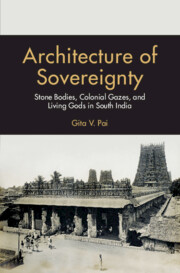Book contents
- Frontmatter
- Dedication
- Contents
- List of Figures
- Acknowledgments
- Notes on Transliteration and Spelling
- Introduction: Sovereignty’s Trace in Architectural Forms
- Part I Stone Bodies
- Part II Colonial Gazes
- Part III Living Gods
- Epilogue: Rejecting the State—Priestly Devotion and Protest in Modern Madurai
- Bibliography
- Index
Epilogue: Rejecting the State—Priestly Devotion and Protest in Modern Madurai
Published online by Cambridge University Press: 19 April 2023
- Frontmatter
- Dedication
- Contents
- List of Figures
- Acknowledgments
- Notes on Transliteration and Spelling
- Introduction: Sovereignty’s Trace in Architectural Forms
- Part I Stone Bodies
- Part II Colonial Gazes
- Part III Living Gods
- Epilogue: Rejecting the State—Priestly Devotion and Protest in Modern Madurai
- Bibliography
- Index
Summary
The annual Vasantam Utsavam (‘spring festival’) at the Madurai temple marks the transition to spring in the Tamil month of Vaikāci (May/June). Movable metal embodiments of Mīnākṣī and Sundareśvara (called utsava mūrtis) travel from their respective inner sanctums to the Pudu Maṇḍapam, and for ten days, loinclothed priests perform rituals inside the pillared hall, where water that once filled the channels in the north and south trenches would have cooled the deities. Priests pray for good cultivation, timely rains, generous yield, and general prosperity. Strong men pull the god and goddess in their carts through the hall's inner corridor three times clockwise (pradakṣiṇa). When the deities are seated on the polished granite stage within the hall's central nave, the priests offer them (behind a green cloth screen) a covered plate of puḷiyōtarai (‘tamarind riceʼ), nīr mōr (‘spiced buttermilkʼ), and fruit such as mangos and cucumbers—devotees, priests, and temple officials will later consume the offering. Then, the priests wave hand-held, oil-wicked brass lamps clockwise (āratī) in front of the idols (Figure E.1).
Before Mīnākṣī and Sundareśvara depart for their temple shrines, the god and goddess pay tribute to Madurai's famous ruler, Tirumala Nāyaka. After the āratī, a priest walks to the stone statuary of the Nāyaka family projecting from columns, and halts at the end of the lineage near the portrayal of Tirumala. The priest conducts rituals on the body of Tirumala's sculpture while the gods watch. The ceremony is the same one done to living people who sponsor the temple: from atop a tall ladder, the priest anoints sandalwood paste on the king's forehead (cantaṉakkāppu), ties a silk scarf around his head (parivaṭṭam), and places a flower garland around his neck (mālai mariyātai) to honor the royal patron (Figure E.2). Acting as a functionary of the god and goddess, the priest presents a plate of coconuts and plantains (prasādam) (Figure E.3). Then, Mīnākṣī and Sundareśvara move outward borne in procession. The divine images are held over the shoulders of temple workers, so they are level with the dynastic portraits that display their reverence to the passing gods with pressed palms. When the deities stop at Tirumala Nāyaka's statue (Figure E.4), the priest raises a fire-flamed lamp at them (Figure E.5), and they are finally carried out of the Pudu Maṇḍapam for the return journey to their own garbhagṛha.
- Type
- Chapter
- Information
- Architecture of SovereigntyStone Bodies, Colonial Gazes, and Living Gods in South India, pp. 281 - 292Publisher: Cambridge University PressPrint publication year: 2023

